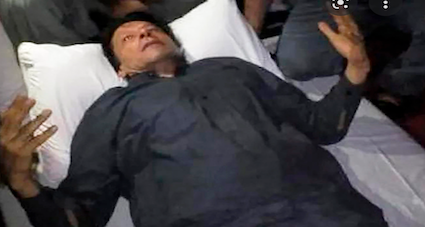In what is being called an assassination attempt, former Pakistan Prime Minister Imran Khan was fired upon and received bullet injuries. The attack was carried out near Gujranwala on Thursday during the long march that he was leading to Islamabad.
Imran is lucky, many a big political figures in Pakistan weren’t so and perished in similar attacks. The long history of political assassinations in Pakistan goes back to October 1951 when the country’s first Prime Minister Liaquat Ali Khan was shot dead in Rawalpindi. Earlier the same year, his government had survived an attempted coup by some leftists and segments of Pakistani military.
The next major political assassination in Pakistan was in May 1958 when an important NWFP politician Khan Abdul Jabbar Khan, brother of Khan Abdul Ghaffar Khan (Baccha Khan, also called Sarhadi Gandhi), was assassinated in Lahore.
In December 2007, Pakistan People’s Party leader and former PM Benazir Bhutto was assassinated in a shooting and suicide bombing at Liaquat Bagh, Rawalpindi. At least 23 other people also died along with her when killers detonated a powerful bomb after firing bullets at her. Over a decade earlier, her brother Mir Murtaza Bhutto was killed in Karachi in September 1996.
Another infamous political assassination, carried out in January 2011, was that of Punjab Governor Salman Taseer. He was killed by his own bodyguard Mumtaz Qadri in Islamabad. After Taseer’s murder, over 500 hardline Islamic clerics voiced support for Qadri as they said that Taseer had supported a blasphemer.
A couple of months later, in March 2011, the-then Federal Minister for Minorities Affairs Shahbaz Bhatti, a Christian, was gunned down in Islamabad. Bhatti was a strong critic of blasphemy laws of Pakistan, specifically 295-A of Pakistan Penal Code (PPC), an omnibus law which has often targeted non-Muslims, including Ahmediyas.
In February 2007, Punjab Minister for Social Welfare Zil-e-Huma Usman was shot down in Gujranwala. Her assassin, Mohammed Sarwar, was angry with her for not abiding by the Islamic dress code.
Prime Ministers, Presidents, Governors, Chief Ministers, sitting and former ministers, eminent front-line politicians, highly placed army and police officials etc are among those who have been killed in such incidents since 1951.
Siddiq Khan Kanju, former Minister of State for Foreign Affairs, was killed in July 2001. Former Sindh Governor Hakim Said was killed in Karachi in 1998.
Former Punjab Chief Minister, Ghulam Haider Wyne, was gunned down in 1993.
Former Martial Law Administrator of Khyber-Pakhtunkhwa, former Governor and Chief Minister, Lieutenant General Fazl-e- Haq, was assassinated in October 1991.
In December 2003, General Pervez Musharraf had survived an elimination attempt when a bomb went off minutes after his convoy crossed a bridge in Rawalpindi. Musharraf was apparently saved by a jamming device in his car that prevented the remote controlled explosives from blowing up the bridge. Four years later, in July 2007, he escaped yet another attempt on his life when around his aircraft was targeted by someone using a submachine gun at Rawalpindi.
In July 2004, Prime Minister-elect Shaukat Aziz had escaped unhurt in a suicide attack on his election rally at Fateh Jang in Attock District which killed five people, including his driver.
In April 2007, the then Interior Minister Aftab Ahmad Sherpao was targeted by a suicide bomber and 28 people had died in that attack at Charsadda. There were three more assassination attempts against him, two at Charsadda, one in December 2007, killing 57 people. In April 2015, another attempt was made at killing him but he dodged death on all four occasions.
In July 2018, a Balochistan politician, Nawab Siraj Raisani, was assassinated in a suicide attack in Mastung while campaigning. Siraj Raisani was one of the 131 people who were killed in the attack. .
(Sant began as a teacher but after six years, joined the Indian Express, Chandigarh in 1990, the year when terrorism was taking its first step in J & K and soon there would be exodus of lakhs of Kashmiri Pandits from the Valley. He subsequently worked for The Statesman, The Times of India and Star News among others. He is based in Jammu since May 2000. He edits epaper.earthnews.in, a newspaper from Jammu presently.)


